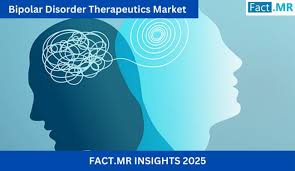Bipolar Disorder Therapeutics Market to Reach USD 10,970M by 2035 | Fact.MR Report

Analysis of Bipolar Disorder Therapeutics Market Covering 30+ Countries Including Analysis of US, Canada, UK, Germany, France, Nordics, GCC countries
ROCKVILLE, MD, UNITED STATES, June 12, 2025 /EINPresswire.com/ -- In 2025, the Bipolar Disorder Therapeutics Market is expected to reach USD 7,860 million. According to Fact.MR's estimate, the valuation is expected to increase at a compound annual growth rate (CAGR) of 3.4%, reaching USD 10,970 million by 2035. The increasing frequency of bipolar spectrum illnesses worldwide, advancements in diagnostic technologies, and the growing need for long-term, specialized mental health management solutions are the main factors driving the industry's growth.For More Insights into the Market, Request a Sample of this Report: https://www.factmr.com/connectus/sample?flag=S&rep_id=7280
Market Drivers: Rising Prevalence and Awareness
The increasing prevalence of bipolar disorder is a primary driver of market growth. Factors such as high-stress environments, changing lifestyles, and substance abuse are contributing to the global rise in bipolar disorder cases. According to Fact.MR, the lifetime prevalence of bipolar disorder is approximately 1%, with a one-year prevalence of about 0.5% worldwide. This growing caseload, combined with early onset in teenagers and improved diagnostic tools, is fueling demand for bipolar disorder therapeutics.
Technological Advancements and New Drug Approvals
The bipolar disorder therapeutics market is undergoing a transformation driven by advancements in pharmacotherapy and digital health solutions. Recent innovations include the development of long-acting injectable (LAI) antipsychotics, such as aripiprazole and risperidone, which improve patient adherence by reducing the frequency of dosing. For example, in September 2022, Otsuka America Pharmaceutical, Inc. and H. Lundbeck A/S received FDA approval for a two-month, ready-to-use aripiprazole injectable for bipolar I disorder and schizophrenia, enhancing treatment outcomes.
Mood stabilizers, such as lithium, valproate, and lamotrigine, remain a cornerstone of bipolar disorder treatment, dominating the market with a 35% share in 2023. These drugs are favored for their ability to manage mood swings and stabilize patients’ mental and emotional states. Additionally, atypical antipsychotics like lumateperone (Caplyta) and cariprazine (Vraylar) are gaining traction due to their improved efficacy and reduced side effects. In April 2022, the FDA approved lumateperone for bipolar depression, marking a significant milestone in addressing depressive episodes.
Digital therapeutics and mobile health platforms are also reshaping the market. Wearable devices and mobile applications, such as Pear Therapeutics’ reSET-O, enable real-time mood tracking and remote consultations, improving patient engagement and adherence. These technologies are particularly impactful in underserved areas, where access to mental health professionals is limited.
Regional Insights: North America and Europe Lead
North America held a dominant 40% market share in 2024, driven by high prevalence rates, advanced healthcare infrastructure, and robust mental health initiatives. The National Institute of Mental Health estimates that 4.4% of U.S. adults live with bipolar disorder, creating significant demand for therapeutics. The U.S. government’s Mental Health Parity and Addiction Equity Act (MHPAEA) ensures equitable access to mental health treatments, further supporting market growth.
Europe accounted for over 30% of the global market in 2024, with Germany, France, and Italy leading due to well-developed healthcare systems and increasing mental health investments. Germany’s bipolar disorder therapeutics market is projected to grow at a CAGR of 2.6% through 2026, driven by rising awareness and supportive government policies. The Asia-Pacific region, with a 23% market share in 2024, is expected to grow at a CAGR of 5.5% through 2031, fueled by improving healthcare access and growing mental health awareness in countries like China and India.
Get Customization on this Report for Specific Research Solutions: https://www.factmr.com/connectus/sample?flag=S&rep_id=7280
Market Segmentation: Mood Stabilizers and Antipsychotics
The bipolar disorder therapeutics market is segmented by drug class, including mood stabilizers, antipsychotics, antidepressants, and others. Mood stabilizers lead due to their effectiveness in managing both manic and depressive episodes. Antipsychotics, particularly atypical antipsychotics, are expected to see significant growth due to innovations like long-acting injectables and their ability to address complex symptoms with fewer cognitive side effects.
By mechanism of action, selective serotonin reuptake inhibitors (SSRIs) held a 25.45% market share in 2023, driven by their role in managing depressive episodes. Long-acting injectables and combination therapies are gaining popularity for their ability to improve adherence, addressing the 40–50% non-adherence rate among bipolar disorder patients.
Competitive Landscape: Innovation and Strategic Partnerships
The market is highly competitive, with key players such as Pfizer Inc., Otsuka Holdings Co., Ltd., AstraZeneca plc, Eli Lilly and Company, and Bristol-Myers Squibb leading through innovation and strategic acquisitions. In December 2023, Bristol-Myers Squibb acquired Karuna Therapeutics, strengthening its neuroscience portfolio with novel psychiatric treatments. Similarly, Eli Lilly’s March 2024 commitment to developing safer mood stabilizers underscores the industry’s focus on addressing unmet needs.
Companies are also investing in personalized medicine, leveraging genetic profiling and AI-driven drug development to tailor treatments to individual patient needs. These advancements aim to improve efficacy and reduce side effects, a critical concern given that adverse effects like weight gain and metabolic disorders often lead to poor medication adherence.
Challenges and Opportunities
Despite its growth, the market faces challenges, including side effects of long-term medication use and disparities in mental healthcare access, particularly in low-income regions. Misdiagnosis and stigma surrounding mental health also hinder timely treatment. However, opportunities abound in emerging markets like Asia-Pacific, where healthcare infrastructure is improving, and in the development of novel therapies, such as glutamatergic modulators and anti-inflammatory compounds.
In the short term (2024–2026), the market will benefit from new drug approvals and digital health integration. In the medium term (2026–2030), personalized medicine and AI-driven diagnostics will drive growth. In the long term (2030–2034)
Future Outlook: A Promising Trajectory
The bipolar disorder therapeutics market is poised for steady growth, with a projected value of US$ 6.8 billion by 2026. Rising awareness, technological advancements, and a focus on patient-centric care will continue to drive demand. As pharmaceutical companies innovate and governments expand mental health initiatives, the market is set to deliver improved outcomes for millions living with bipolar disorder.
Check out More Related Studies Published by Fact.MR:
Peptide-based cancer therapeutics market is forecasted to increase from a valuation of US$ 10.1 billion in 2023 to US$ 21.4 billion by the end of 2033
Peptide-based Infection Therapeutics Market is forecasted to increase at a high CAGR of 8.3% over the next ten years.
S. N. Jha
Fact.MR
+1 628-251-1583
email us here
Legal Disclaimer:
EIN Presswire provides this news content "as is" without warranty of any kind. We do not accept any responsibility or liability for the accuracy, content, images, videos, licenses, completeness, legality, or reliability of the information contained in this article. If you have any complaints or copyright issues related to this article, kindly contact the author above.
Foundry512 Expands Talent Roster, Hiring for Key Roles Across Media, Accounts, Projects, and Creative
Turner Home Team Expands Home Buying Services Statewide: We Buy Houses Across North Carolina fast for cash.
Sullivan’s Castle Island and Castle Island Brewing Co. Launch 'Rickey Business' Lager to Celebrate James Beard Award
Kalendarium
Więcej ważnych informacji
 Jedynka Newserii
Jedynka Newserii

 Jedynka Newserii
Jedynka Newserii

Prawo

KE proponuje nowy Fundusz Konkurencyjności. Ma pobudzić inwestycje w strategiczne dla Europy technologie
W środę 16 lipca Komisja Europejska przedstawiła projekt budżetu na lata 2028–2034. Jedna z propozycji zakłada utworzenie Europejskiego Funduszu Konkurencyjności o wartości ponad 400 mld euro, który ma pobudzić inwestycje w technologie strategiczne dla jednolitego rynku. Wśród wspieranych obszarów znalazła się obronność i przestrzeń kosmiczna. Na ten cel ma trafić ponad 130 mld euro, pięciokrotnie więcej niż do tej pory.
Firma
Były prezes PGE: OZE potrzebuje wsparcia magazynów energii. To temat traktowany po macoszemu

Choć udział odnawialnych źródeł energii w miksie energetycznym Polski jest stosunkowo wysoki i rośnie, to ten przyrost jest chaotyczny i nierównomiernie rozłożony miedzy technologiami – wskazuje Forum Energii. Dodatkowo OZE potrzebują wsparcia magazynów energii, a zdaniem Wojciecha Dąbrowskiego, prezesa Fundacji SET, ten temat jest traktowany po macoszemu. Brak magazynów powoduje, że produkcja energii z OZE jest tymczasowo wyłączana, co oznacza marnowanie potencjału tych źródeł.
Infrastruktura
Wzrost wynagrodzeń ekip budowlanych najmocniej wpływa na koszty budowy domu. Zainteresowanie inwestorów mimo to nieznacznie wzrasta

Budowa metra kwadratowego domu w Polsce kosztuje od 5,55 do 6 tys. zł w zależności od województwa – wynika z najnowszych analiz firmy Sekocenbud. Najdrożej jest w Warszawie, gdzie cena za metr kwadratowy domu przekroczyła już 6,2 tys. zł. Na przyrosty kosztów budowy domu wpływają zarówno drożejące materiały budowlane, jak i wyższe wynagrodzenia pracowników. Inwestorzy nie rezygnują jednak z budowy domów jednorodzinnych, co ma związek m.in. z wciąż wysokimi cenami mieszkań czy też obniżką stóp procentowych.
Partner serwisu
Szkolenia

Akademia Newserii
Akademia Newserii to projekt, w ramach którego najlepsi polscy dziennikarze biznesowi, giełdowi oraz lifestylowi, a także szkoleniowcy z wieloletnim doświadczeniem dzielą się swoją wiedzą nt. pracy z mediami.








.gif)

 |
| |
| |
|